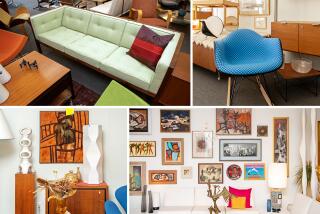Suitable for Framing
If you spend thousands of dollars on wedding photographs, the last thing you want is to display them in a shaky black 8x10 frame from the discount store. Some newly married couples turn to antique or custom frames, which add character to traditional portraits.
But beware: Even interior designers can be confused by the vast array of framing choices available and often rely on custom framers to help.
Leslie Sieswerda, education manager at Larson-Juhl Framing Products in Norcross, Ga., says the place to start is with the item to be displayed.
âFrame photographs that best express your personality,â she says.
You might also consider framing other items from your big day, a piece of antique lace from a veil, pressed flowers from a bouquet, a marriage certificate.
With piece in hand, tell the framer your budget, where the piece is to hang, whether it should be hinge mounted and if it requires conservation framing and glass.
Generally, hinge mounting is for prints and other paper items. Conservation framing is best for fine art and antiques.
Then work together in selecting a frame and mat board, maybe even a molding and fillet.
The mat board is a paper border that lifts the glass slightly away from the artwork, allowing it to âbreathe.â
Moldings and fillets are decorative borders, usually wood or metal, added to the frame.
And though you should consider the style and color of the room where it will hang, Sieswerda reminds that âthe frame is there to enhance the object framed and should be able to stand on its own merits.â
A custom frame well-chosen should enhance the portrait it surrounds and project the period and level of formality of the room where it hangs.
While a simple frame and complementary mat often is best, antiques are highly prized. And for people who frame the same way they furnish--elaborately and eclectically--more is sometimes better.
Thus, a triple frame and double mat could be considered due respect for an important portrait.
âMultiple framing does raise the cost, but we are finding that customers are less concerned about cost than they are about a unique look,â says Paula Jackson, product design manager for contemporary frames at Larson-Juhl. The company is one of the worldâs largest suppliers of stock moldings for custom framing.
In the trade, multiple layers are called ânesting.â Nesting also is used to create a shadow-box style of frame for collectibles and mementos.
âSome people want to frame a memento such as a photograph and items that belonged to that person, say a handkerchief and a glove or a gold watch,â says Linda Jamison, Larson-Juhlâs design manager for traditional frames.
Most custom framers worth their fillet--a small molding that often fits the inside edge of the mat--wonât flinch at requests to frame a hat, a kimono, a piece of fine china.
And while almost anything can be framed, custom work isnât cheap. Frames are ordered by the running foot, which costs roughly $6 to $60 per. Thus, an 8x10 custom frame at $10 a linear foot would be $30 plus glass, mat and labor. Labor is costly because from six to 20 or more separate steps are required to complete a custom piece.
Hand-carved wood frames, which Jamison says can cost up to $300 a linear foot, generally are imported from Spain, Italy and France. Domestic frames that look hand-carved are usually coated with a synthetic material that is wheel-cut.
Donât look for bargains in old frames. Antique European frames--especially from the Renaissance through the 18th century --never lost their value. And American frames, once throwaways, are increasing in value.
Recent use of antique American frames started with museum curators and other cognoscenti.
Now, it isnât uncommon to pay up to $1,000 for an old American frame, or into five figures in New York and New England, the main centers of interest.
âIt is not enough to use vintage American frames with paintings of the same period,â author Eli Wilner says. âIt should be the type of frame that the artist would have been likely to use.â
Wilner, who compiled âAntique American Frames: Identification and Price Guideâ (Avon, $15 softcover), is also a New York dealer in American frames.
Where to find antique frames? Antiques stores and flea markets, auction houses and estate sales.
Signed or recognizable frames, such as those designed around the turn of the century by architect Stanford White for his artist friends, are highly collectible and very expensive.
Those who canât find, or donât want to pay for, old frames should consider copies. Wilner, who has 2,000 originals, also makes custom reproductions.
In any case, most traditional frames are based on antique prototypes. Greek, Roman and Renaissance architectural ornament have furnished most of the motifs. The 19th century has also provided models.
Low-relief Victorian style frames made with vintage embossing wheels are among Larson-Juhlâs most popular frames. They are part of the companyâs Queen Victoria Collection stocked by many framers across the country.
Those lucky enough to have or find an old frame should exercise restraint when refinishing it.
Donât remove any finish before you know what you have, Wilner says, because the original finish or even old gilding might still exist. Eliminating it would reduce the frameâs value.
âWe have come full circle away from the idea that you should strip a frame down to the bare wood,â Wilner says. âMany frames were destroyed that way.â


